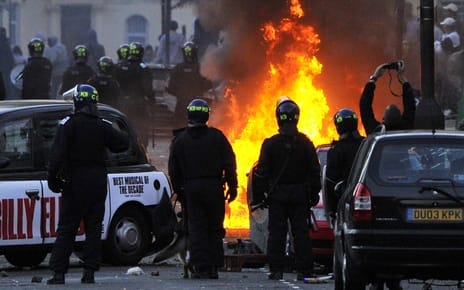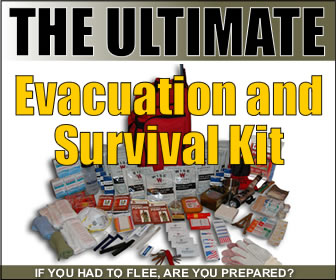John Hudson Aug 10, 2011
With British Prime Minister David Cameron authorizing the use of rubber bullets and water canons in wake of the turbulent London riots spreading through Britain, questions have been raised about how authorities in the U.S. would respond to a similar domestic disturbance threatening the nation’s stability. According to National Journal‘s White House correspondent Marc Ambinder the U.S. already has a game plan in place. “If what happened in London ever happened in the US, the military has plans — CONPLAN 3501 and 3502 — to suppress the ‘insurrection,’ he tweeted. The mysterious reference to a numbered military plan generated a flurry of interest on Twitter as NPR host Michele Norris shot back:”I want to know more about the military’s plan to suppress any potential ‘insurrection.’– CONPLAN 3501 and 3502????”
Interestingly, the CONPLAN (which stands for an “operation plan in concept format” at the Pentagon) Ambinder referenced is a popular subject among conspiracy theorists and critics of martial law. According to the public policy organization GlobalSecurity.org, CONPLAN 3502 is the U.S. military’s plan for assisting state and local authorities in the event of a riot or major civil disturbance: “Tasks performed by military forces may include joint patrolling with law enforcement officers; securing key buildings, memorials, intersections and bridges; and acting as a quick reaction force.”
It derives its constitutional backing from Article I, Section 8 stating that “Congress shall have power… to provide for calling forth the Militia to execute laws of the Union, suppress Insurrections, and repel Invasions” and is rumored to have been activated during the aftermath of Hurricane Katrina, during the 1999 Seattle WTO riots and during the 1992 Rodney King riots in Los Angeles. But, according to Nate Jones at the National Security Archive, “because historic Garden Plot activity was classified and current activity likely remains so, it is difficult to discern exactly how many times Garden Plot was evoked.” What jarred Jones upon looking at internal military documents, were the “indicators of potential violence,” which were especially racially oriented:

According to Global Security, the federal government’s power to control civil disturbances was increased in 1970. Here’s an outline of what that involved:
375,000 National Guardsmen and 14,000 Army Reservists had been trained in riot control as the year closed. The Army National Guard conducted, at the expense of regular training, sixteen hours of refresher civil disturbance training. Some states also carried out civil disturbance command post exercises in conjunction with local and state civil authorities. The Army Reserve had three infantry brigades which were part of the federal military contingency force for the control of civil disturbances. These units also conducted sixteen hours of refresher civil disturbance training at the expense of primary training. This additional responsibility of the Reserve Components called for their immediate availability in times of natural disasters, civil disturbances, and other emergencies.
Update: Ambinder also points to an Army slideshow detailing more about CONPLAN 3501. One of the slides has a breakdown of what army officers are in charge of which areas of the country. Click the link to see the whole slideshow.

Want to add to this story? Let us know in comments or send an email to the author at: jhudson@theatlantic.com. You can share ideas for stories on the Open Wire.
Original article can be viewed here
ADVERTISEMENT





You must be logged in to post a comment Login